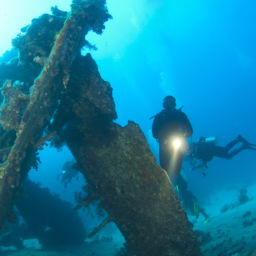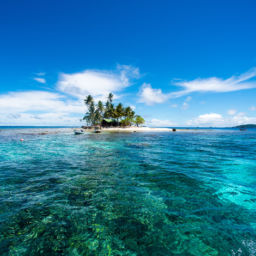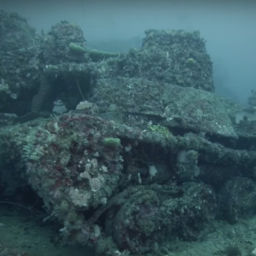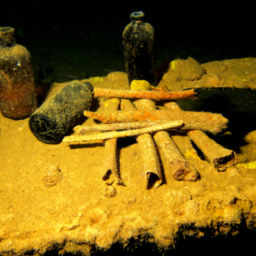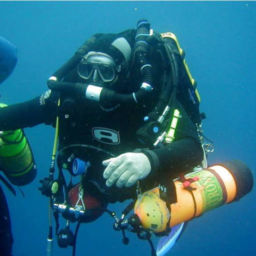Many regular wreck divers think Chuuk Lagoon offers the best wreck diving in the world. Other divers know the name but don’t know what makes the area so special. Why is it so revered, and what should you expect if you visit? Here’s an overview of what makes scuba diving in Chuuk Lagoon so special.
Lying 1,500 miles (2,400 km) northeast of Indonesia and 1,000 miles south of Japan, Chuuk (or Truk Lagoon as it was formerly known) is a cluster of small islands making up one of four of the Federated States of Micronesia. The lagoon sits inside a 47-square mile (122 km) atoll. Most of the 50,000 inhabitants live on the main Islands of Weno, Dublon, Eten, Fefan and Uman.
Brief history of Chuuk Lagoon
After World War I, Japan received a mandate over the islands of Micronesia. This allowed them to exploit the area for economic gain. As they began to militarize on an industrial scale during the build-up to World War II, they realized that Truk’s geography would make a naval invasion extremely difficult. Thusly, they turned it into a vital strategic outpost for naval operations in the Pacific. The Japanese built infrastructure and fortifications on many of the Islands, including roads, trenches, bunkers, caves, five airfields, a seaplane base, a submarine-repair base, a radar station, and mortar emplacements and coastal defense guns. By the time the war started, The Allies regarded Truk as the “Gibraltar” of the Pacific. Around 28,000 Imperial Japanese Navy (IJN), and almost 17,000 Imperial Japanese Army (IJA) personnel were stationed there. The lagoon served as an anchorage for the entire IJN combined fleet.
Operation Hailstone
In order to attack mainland Japan, the United States first had to capture numerous islands, including the Marshall Islands, Saipan, Iwo Jima, Kwajalein, Majuro and Truk. For Truk, they devised Operation Hailstone, which would consist of an airborne attack comprised of five fleet carriers, four light carriers, seven battleships, 10 submarines, as well as numerous heavy and light cruisers, destroyers and battleships. Five hundred aircraft operating from the carriers were to conduct the attack, with the intention of catching the Japanese forces by surprise. In this way, the Americans hoped to quickly neutralize any aerial threats and sink as many Japanese ships as possible.
On February 6, 1944, two reconnaissance planes flew over Chuuk Lagoon to photograph potential targets. Although there was cloud over much of the atoll, they managed to photograph many ships of the combined IJN fleet. The Japanese took this as a warning of an imminent attack and withdrew four carriers, numerous cruisers and destroyers, and the pride of the fleet — the battleship Musashi.
The attack
Before dawn on February 17, 1944, a taskforce took position 94 miles east-northeast of Dublon. At dawn, the first wave of U.S. fighters and fighter-bombers reached Truk. The Japanese had their guard down, but responded quickly, trying to get as many aircraft in the air as possible. But it was too late — U.S. aircraft bombed and strafed runways, giving parked and taxiing aircraft little chance. The planes that got airborne were quickly overwhelmed as the U.S. had achieved air superiority quickly. This allowed them to concentrate their airpower on the merchant ships anchored in three main locations: the 4th and 6th fleet anchorages, and the repair anchorage. Over two days, U.S. aircraft sank over 220,000 tons of shipping. The official Operation Hailstone report lists 42 combat, auxiliary, and merchant vessels as being sunk, with a further 28 damaged to varying degrees. The Americans also destroyed over 350 aircraft.
Aftermath and first dives
Following the first attack and subsequent attacks in April and June 1944, the Allies moved on with their advance toward Japan. Truk was left a toxic graveyard of sunken ships, leaking huge quantities of oil and gasoline into the lagoon. The Japanese on the islands, along with the local population, were also left without any hope of reinforcement. Rarely reported is that over 10,000 Chuukese starved to death in the months following the attacks. A similar number of Japanese personnel died as well as the oil slicks killed all marine life.
When the war ended, the world largely forgot about Chuuk Lagoon and the devastation that occurred there until, in 1969, members of Jacques Cousteau’s team visited to find and document the wrecks. They found 30 ships and filmed the documentary “Lagoon of Lost Ships.” They, unfortunately, also took tons of artifacts from the wrecks, which are presumed to be sitting in a warehouse in Paris to this day. But their film did shine a spotlight on Truk, bringing it to the wider diving community’s attention.
A Chuukese man named Kimiuo Aisek really made it possible for divers to visit Chuuk Lagoon. As a laborer for the Japanese during the war, he witnessed the attacks and began diving the wrecks in the 1970s. He purchased the Continental Hotel and renamed it the Blue Lagoon Dive Resort, turning it into the first dive shop in Chuuk. It’s still there today, run by his son, as well as numerous other operators, both land-based and liveaboard.
Scuba diving in Chuuk Lagoon today
The lagoon holds over 60 vessels — ships, merchant and military, various types of aircraft, and a submarine. Most of these are diveable, sitting on the seabed at depths ranging from 49 to 213 feet (15 m to 65 m). Lying in the lagoon for the last 73 years, the wrecks are in varying states of decay due to damaging storms and typhoons and the onslaught of rusting. Divers have also caused degradation with bubbles, bad buoyancy, bad finning and grasping hands. Bridges and funnels have also been destroyed by two of the liveaboards anchoring on the wrecks in stormy weather. Generally speaking, the deeper wrecks have degraded the least, but some of the shallower wrecks are also in remarkable condition.
Because Chuuk lies within an atoll, it is protected from strong ocean currents. There’s usually no current at all on the wrecks. The water temperature is a consistent 84 to 86 F (29 to 30 C) year-round, and the visibility ranges from 33 to 160 feet (10 to 50 m) on the deeper wrecks. Depth notwithstanding, it’s the easiest diving you’ll ever do — a big, warm bathtub.
Diving the wrecks
There are far too many wrecks to cover exhaustively here, but on each you will find evidence of damage from fires, torpedoes, mines or bombs. They contain a mountain of artifacts, including cars, trucks, bulldozers, tractors, steamrollers, tanks, ammunition, torpedoes, shells, mines, beer and sake bottles, shoes, boots, china, uniforms, tools, rifles, lanterns, compressed-air cylinders, machine guns, bicycles, medicine bottles, bags of cement, wheelbarrows — the list is endless. Many of the engine rooms are still accessible and in good condition, and here you can see cylinders, engines, generators, compressors, gauges, valves, tools and much more.
In the past, there were human remains on the wrecks. Japanese divers removed as many as they could find, however, and gave them a Shinto burial in the 1980s. There are still some bones present however.
There’s also an abundance of marine life on and around the wrecks, including coral growth, anemones and schooling tropical fish. Blacktip reef sharks are common, as are dolphins and eagle rays. Not so common — but still possible —are manta rays, tiger, hammerhead, bull and oceanic whitetip sharks, although they tend to stay on the atoll shelf.
Getting there
Chuuk is a long way from anywhere. Most visitors will require three flights or more to get here, and the easiest route is via Guam. From there a United Airlines flight runs to Chuuk every two days. Those coming from Australia can fly Air Niugini via Port Moresby and Pohnpei. Local hotels are very basic, as are goods available in shops. Internet access is neither fast nor reliable — expect to be largely cut off while you’re here.
Diving in such a remote location also brings its own set of challenges. Bring all your own dive gear and make sure everything is in working order before you arrive. Bring spare parts, especially regulator O-rings, mask straps, and zip ties. Tools such as pliers and Allen wrench sets are also a good idea. Local dive operators will do their best to keep you diving, but don’t rely on them to have everything you may need.
What to expect
If you are technical diving, bring your own full rigging kits, including hose clips, bolt-snaps for sidemount, and hose retainers. Also bring your own stage regulators, labeling tape and even marker pens. Rebreather divers should bring spare O-ring kits and virkon disinfectant and specify in advance whether they want to use aluminum or steel tanks. Dive shops will supply sofnolime and trimix if requested. Shops tend to use oxygen generators, so any 100-percent O2 fills will be between 87 and 93 percent.
Many of the wrecks lie in recreationally accessible depths, but you will need advanced certification to dive here. A nitrox cert is also wise since you’ll be doing multiple days with multiple dives. Having your deep specialty is even better. But know that on those wrecks the top of the deck is typically at 130 feet (40 m), which means a short bottom time and not much to see on the ascent.
Regarding wreck penetrations, many of the accessible bridges are more like swim-throughs. If you venture into the engine rooms, however, you are often well beyond the light zone in a maze of corridors. Some wrecks are on their side or upside-down. They can be very confusing and there’s a lot of silt you might disturb. Wreck and advanced wreck training is a must for any conscientious diver. Also note that there is live ordnance on many of the wrecks, so keep your distance and dial in your buoyancy.
Learn your history
Every wreck has a story, both before and during WWII, as well as on the days of the attack. Thus, learning a bit of history before a visit will enhance your experience immeasurably. With so many wrecks to dive, it’s good to arm yourself with a little knowledge of what you’re diving on. A seven-day trip will hardly scratch the surface. And, without a little knowledge, every wreck will just be another “Maru” (merchant ship).
Finally, remember that Chuuk was the site of a devastating attack in which thousands of Japanese soldiers died. The dive sites are war graves and you should treat them with respect. As with any other dive site, don’t touch anything. These wrecks have rich histories explaining how they ended up here and diving them is an awe-inspiring experience. Anyone with even a passing interest in wreck diving should not miss scuba diving in Chuuk Lagoon.



